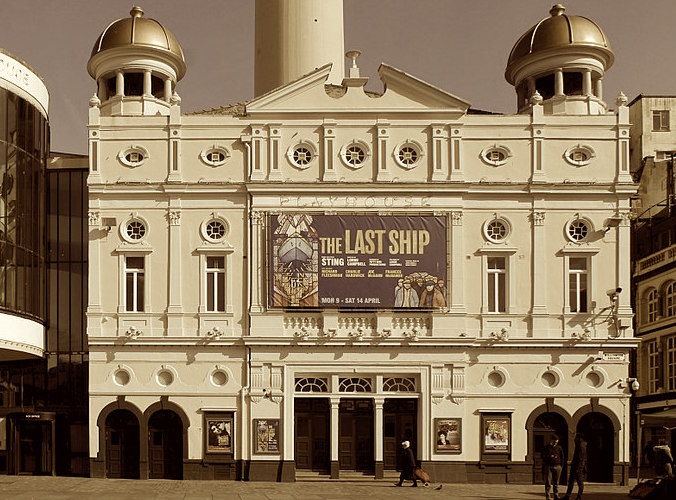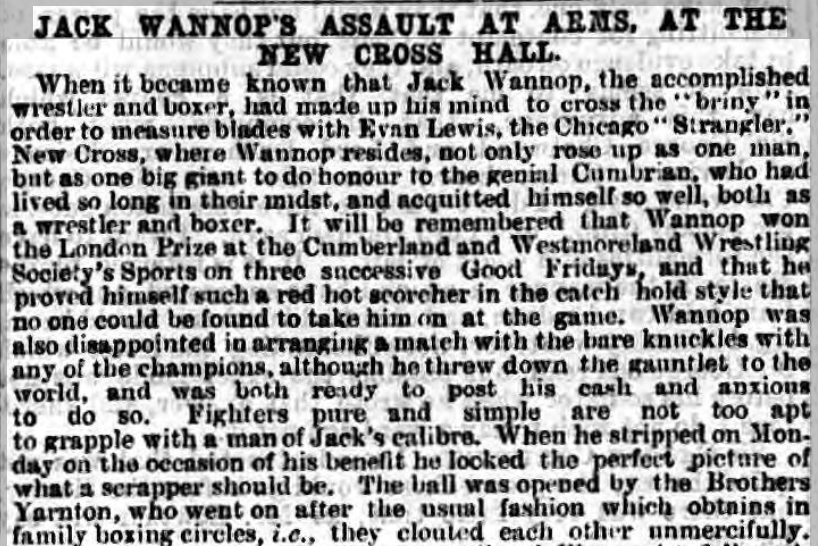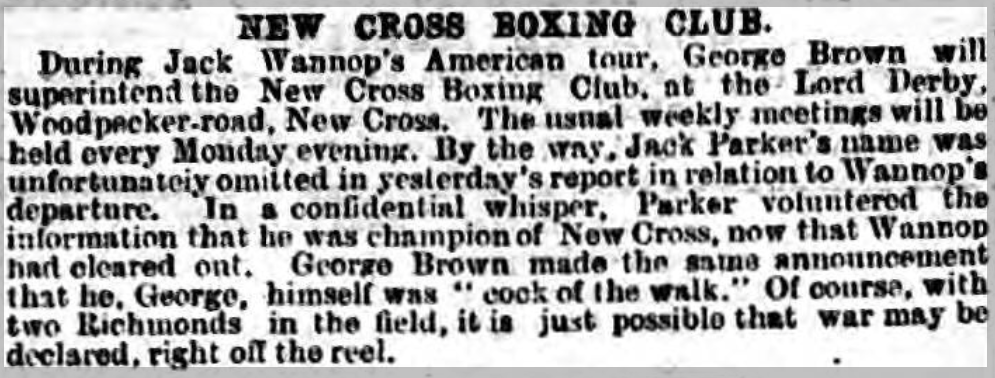On Wednesday 15 February 1888 Jack Wannop said goodbye to Miriam and their clutch of small children and left his home at 105 Woodpecker Road, New Cross, London, for Euston and the midday train to Liverpool.
Met with a cordial reception at Lime Street station by a Mr Snell, The Sporting Life reported that Jack and his friend Harry Hoare first stopped by Fred Hall’s Court Opera House Hotel where they were greeted by the landlord, his brother, and a host of friends for a first round of refreshments
Next up was Sanger’s Circus, then on to the Star Music Hall, where the party were joined by a Jim Carney and Anthony Diamond and had a lovely time under the attention of a Mr Maguire. Jack and Harry then checked into the Victoria Hotel for the night.

Following some hurried visits the next morning, possibly with a few sore heads, Fred presented Jack with ‘many useful items’, including a bottle of brandy. Jack and his party at last boarded a National Line steamer – the Egypt – and Hoare popped the brandy cork the second they stepped on deck. After the usual hand-shaking, the good ship began to move down the river, and gradually faded out of sight.
A few days earlier, Jack’s farewell assault-at-arms had been held at the New Cross Public Hall, a major entertainment venue which stood on what is now Lewisham Way, slightly further back from the road than the current Big Yellow Storage Facility and pleasingly-attractive deco block of flats above Ladbrokes. On the morning of the show, The Sporting Life paid tribute to our Great British Hope:
JACK WANNOP’S FORTHCOMING VISIT TO AMERICA
Wannop’s farewell assault at arms at the New Cross Hall this (Monday) evening, prior to his visit to the States, promises to shine forth as one of the best affairs of its kind. Jack has been located in the neighbourhood where he now resides for several years, and his boxing and wrestling club, to which he has devoted a considerable amount of attention, has the means of bringing an amount of undeveloped talent to the front almost unprecedented.
Wannop is an immense favourite both in his own locality and wherever he has boxed and wrestled during his sojourn in the metropolis, and will be supported on the occasion of his farewell benefit by numerous gentleman who have benefited by his tuition, and also by the elite of the pugilistic, wrestling, and fencing world.
In late 1887 Jack had declared through the press, in a nice bit of PR, that because there were no wrestlers in London anywhere near his calibre, he would have to take his talents to America instead. Or, as The Sporting Life put it:
“As the Mountain refuses to come to Mahomet the latter is going for the Mountain.”

His target was Chicago’s Evan ‘The Strangler’ Lewis (1860-1919), who was also known as the ‘Chicago Strangler’, or, if you wrote sports copy for the UK’s northern daily newspapers in February 1888, “a Yankee professional who has been given a suggestive alias”. We’ll meet him properly in my next blog post, but briefly, Lewis is the first officially recognised American Heavyweight Champion wrestler. He is not to be confused with Ed ‘Strangler’ Lewis, who rose to prominence some years later.

Jack’s ‘native’ wrestling style was Cumberland and Westmorland (Cumbrian) although he was by all accounts an expert in every other style as well, from Cornish to Devon to Lancashire.
From what I understand, we can credit Jack with almost single-handedly popularising the ‘new’ rules of Catch-as-catch-can (Catch wrestling) in London in the 1880s. Well, I’m going to be arguing that in my MA dissertation, at least. But as the Kentish Mercury noted on February 10th 1888: he gained such prowess in it, he couldn’t find anyone who would accept his challenges.
Catch wrestling was Lewis’s preference, and this is what Wannop agreed to in a grand title match: Catch-as-catch-can, no holds barred, two shoulders on the floor makes the fall. The winner would take 75% of the $1,000 purse with the rest to the loser.
Jack was billed as Champion of England.
His farewell event at the New Cross Hall was lengthy and good, with boxing from Tom Thompson, Bill Natty, Dick Leary and a host of other local and wider London athletes, including the ‘Langthorne Midgets’ who pop up occasionally in other press coverage but I’m yet to find much out about them.

The ‘Sisters Mills’ on the bill are an incredibly exciting find – the Kentish Mercury’s short report of the night did not go into detail, but listed them alongside the boxers, rather than as separate entertainment (e.g. a singing act as might be typical alongside a boxing bill). The Sportsman supplied the goods – the sisters donned gloves and “set about each other in a vigorous fashion, for the orthodox three rounds.”
As usual, it’s The Sporting Life that really comes through. Not only were the sisters “well built” and set about the match “scientifically” – they were also black. The writer does not treat the women’s match as a novelty, unless I am misreading the tone here: “However Wannop unearthed such talent was the greatest mystery on the board to all concerned,” the reporter concluded. Although, he also used an unfortunate racial epitaph for the Mills and the night’s other black boxer James Caylor.
Needless to say, the Mills sisters received thunderous applause. And I’m just happy my fantasy BBC Ripper Street meets Peaky Blinders wrestling drama will finally get some female characters in it.
While not wholly unique – there are many documented women boxers across the Georgian, Victorian and Edwardian periods, including numerous sister acts – the Mills are the first example of women boxers I’ve found to date demonstrating their badassery in New Cross. I’ll endeavour to find out more about them, and will certainly be including them in future posts exploring Wannop’s egalitarianism as a fighter and promoter (compared with, let’s say, Sullivan in the US during the same period…) and how diversity in the ring reflected diversity in the New Cross and Deptford area. Jack’s New Cross gyms welcomed local black fighters, while also later becoming a key destination for Asian and Middle Eastern athletes on international tours.
UPDATE 9/4/19 – I’ve found out a bit more about the Mills sisters and will share it with you soon. They might actually have been Mexican. Or Creole. The newspapers tend to… make stuff up a lot? More to come!
On with the show. Other wrestling, boxing and sword fighting exhibitions took place across the night, with the wind-up being ‘three very clever rounds’ of Cumberland and Westmorland wrestling between Wannop and East End champion Jem Young.

Larry Donovan, an American who was very famous for jumping from bridges (GREAT story, check him out), was on hand to attend on performers (for some reason!?); Professor J. Harrison demonstrated his club swinging; and an artist by the name of Graham Ross sat in the corner sketching ‘celebrities’, including the Prime Minister, reported the Kentish Mercury. The PM wasn’t there or anything, people just apparently wanted pictures of him drawn at a boxing party.
Ross’s caricatures of Wannop, Kilrain and John L. Sullivan were particularly well received, and what I wouldn’t give to see them now. If Sullivan and Kilrain had actually been in attendance, the press would have commented on it so I assume neither were – although both were in London at this time, with Sullivan training hard for his forthcoming March title match in France against Charlie Mitchell, who was being helped in his training by Kilrain.
As befits his celebrity, Jack wasn’t content with just one leaving do, so also arranged a parting competition for members of his New Cross Boxing Club, which was based at The Lord Derby pub. The prize for the heavyweights was a silver watch, while the lightweights battled for a gold ring.

A brief quote from The Sporting Life, reporting from the lightweight final in which H. Penton took on A. Bartholomew, will tell you everything about why I enjoy this subject matter and these old newspapers so very, very, much:
JACK WANNOP’S BOXING COMPETITION AT THE LORD DERBY, NEW CROSS
Round 1. – Bartholomew led off smack on his opponent’s dial plate, and followed up the visitation with several thick-‘uns in Penton’s bread basket. Both lads then went in hammer and tongs, Bartholomew putting in a terrific right-handed, was well countered. Again Bartholomew scored with the left – a fearful sneezer, and had decidedly the best of the deal when “Time!” was called.
Penton recovered, to the astonishment of the company, and despite “Time!” being called on the final round, gave [Bartholomew] no rest, and pasted him all over the ring to such a tune that when a fourth round was ordered Bartholomew declined the encounter…
Later in the night, Boxer H. Goddard – the taller man by half a foot – beat W. Bartlett, although Round 2 resulted in a “hugging encounter” prompting Jack Wannop to yell “stop that wrestling business, I thought I had taught you better manners!” as everybody laughed.
The night took a turn when, unbeknownst to Wannop, two heavyweight fighters he’d paired for a match turned out to have “some little difference of opinion existing between them” i.e. a bit of a grudge (I’ll assume it was about a girl), resulting in a “tit-bit of the evening”. The “claret” flowed heavily from Brodrib (“a long, lean, lanky, customer with an immense reach and game as a pebble” – The Sporting Life) at the hands of Tom Noble, but Brodrib stood his ground.
Tom ‘Curley’ Thompson later peeled off and took the floor with Bill Oliver “which again went to prove that exhibition sparring at New Cross is superior to the genuine business” (LOVE this quote) before wrestling the best of three falls with Dick Leary.

In my next post we’ll follow Jack as he lands in America and prepares to wrestle the Chicago Strangler.
There are plenty more stories to come too from that lengthy tour, which involved fire, scandal, illness, deceit, and a hell of a bout between Wannop and former black heavyweight boxing champion George Godfrey (1853-1901). Godfrey was one of several top fighters denied a chance at the world heavyweight title by John L. Sullivan because of his race, and Sullivan’s racism. We’ll also meet Con Riley, who got his ass kicked so hard by Wannop he ran out the ring in the middle of the match and out into the night.
I’ll leave you with this fantastic quote from The Sporting Life as they bid Jack Wannop – wrestler, boxer, coach, promoter, pillar of the community, “the most popular man in New Cross” – a fond goodbye on Wednesday 15 February 1888:
New Cross is now reft of its chiefest ornament, and in the breasts of the gladiators of the district, a hope, but perhaps a vain one, exists in the interim, “some new Napoleon may arise” to represent Jack Wannop in his absence.
P.S. Looks like George Brown, Jack Parker, and the ‘two Richmonds’ were more than happy to try…
*Dropkick Murphys-esque fight theme plays*

[…] farewell benefits in New Cross were covered by the press, interviews conducted, and arrangements made. He was set to meet his […]
LikeLike
[…] struggling to get a wrestling match with a “foeman worthy of his steel”, in ‘88 Jack Wannop accepted the challenge of Evan ‘The Strangler’ Lewis’s managers in the United States, Lewis being the most feared and dominant wrestling in America at this time. […]
LikeLike